A New Family of Phase-Fitted and Amplification-Fitted Runge-Kutta Type Methods for Oscillators
Abstract
In order to solve initial value problems of differential equations with oscillatory solutions, this paper improves traditional Runge-Kutta (RK) methods by introducing frequency-depending weights in the update. New practical RK integrators are obtained with the phase-fitting and amplification-fitting conditions and algebraic order conditions. Two of the new methods have updates that are also phase-fitted and amplification-fitted. The linear stability and phase properties of the new methods are examined. The results of numerical experiments on physical and biological problems show the robustness and competence of the new methods compared to some highly efficient integrators in the literature.
1. Introduction
Recently, some authors have proposed to adapt traditional integrators to the oscillatory character of the solution to the problem (1.1) (see [4–7]). Bettis [8] constructs a three-stage method and a four-stage method which solve the equation y′ = iωy (i2 = −1) without truncation error. Paternoster [9] develops a class of implicit methods of Runge-Kutta (RK) and Runge-Kutta-Nyström (RKN) types by the trigonometric fitting technique. For oscillatory problems which can be put in the form of a second-order equation y′′ = f(x, y), Franco [10] improves the update of the classical RKN methods and proposes a family of explicit RKN methods adapted to perturbed oscillators (ARKN) and a class of explicit adapted RK methods in [11]. Anastassi and Simos [12] construct a phase-fitted and amplification-fitted RK method of “almost” order five. Van de Vyver [13] investigates phase-fitted and amplification-fitted two step hybrid methods (FTSH). For other important work on frequency dependent integrators for general second-order oscillatory equations, the reader is referred to [14–18]. Many authors focus on effective numerical integration of specific categories of oscillatory problems. For example, Vigo-Aguiar and Simos [18] construct an exponentially fitted and trigonometrically fitted method for orbital problems. The papers [19–21] have designed highly efficient integrators for the Schrödinger equation.
Based on the previous work, we consider, in this paper, phase-fitted and amplification-fitted RK type integrators whose coefficients in the update depend on the product of the fitting frequency and the step size. In Section 2, we present a result on order conditions for frequency-depending modified Runge-Kutta type methods. Section 3 introduces the notion of phase-fitted and amplification-fitted RK type methods (FRK) and derives the phase-fitting and amplification-fitting conditions. In Section 4 two FRK methods of order four and two FRK methods of order five are constructed. Their error coefficients and error constants are also calculated. The linear stability and phase properties of the new FRK methods are analyzed in Section 5. In Section 6, numerical experiments are carried out to illustrate the effectiveness and superiority of our new methods compared to two well-known highly efficient integrators we have chosen from the recent literature. Section 7 is devoted to conclusive comments.
2. Order Conditions for RK Type Methods with Frequency-Dependent Weights
Theorem 2.1 (see Franco [11].)The modified RK type method (2.1) has order p if and only if the following conditions are satisfied:
3. Phase-Fitted and Amplification-Fitted Conditions
Definition 3.1 (see [22].)The quantities
Definition 3.2. The quantities
The following theorem gives the necessary and sufficient conditions for a modified RK method and its update to be phase-fitted and amplification-fitted, respectively.
Theorem 3.3. (i) The method (2.1) is phase-fitted and amplification-fitted if and only if
(ii) The update of the method (2.1) is phase-fitted and amplification-fitted if and only if
The proof of this theorem is immediate.
4. Construction of New Methods
Now we proceed to construct modified RK type methods that are both phase-fitted and amplification-fitted based on the internal coefficients of two classical RK methods. For convenience we restrict ourselves to explicit methods.
4.1. Fourth-Order Methods
It can be seen that as ν → 0, both the methods Simos4 and FRK4 reduce to a classical RK method of order four (on page 138 of [3]), which we denote by RK4. The method RK4 is called the prototype method or the limit method of the methods Simos4 and FRK4. Moreover, as ν → 0, both Simos4 and FRK4 have the same error constant as that of RK4: .
4.2. Fifth-Order Methods
It can be verified that the method given by (4.17) and (4.28) is of order five. We denote the method by FRK5b.
It can be seen that as ν → 0, both the methods FRK5a and FRK5b reduce to a classical RK method of order five (on page 178 of [3]), which we denote by RK5. The method RK5 is called the prototype method or the limit method of the methods FRK5a and FRK5b. Moreover, as ν → 0, both FRK5a and FRK5b have the same error constant as that of RK5: .
5. Analysis of Stability and Phase Properties
Definition 5.1. The region in the μ-ν plane Ω = {(μ, ν)∣μ > 0, ν > 0, |R(iμ, iν) : ≤1} is called the imaginary stability region of the method (2.1) and the closed curve defined by |R(iμ, iν)| = 1 is called the stability boundary of the method.
The imaginary stability regions of the methods Simos4, FRK4, FRK5a and FRK5b are depicted in Figures 1 and 2.
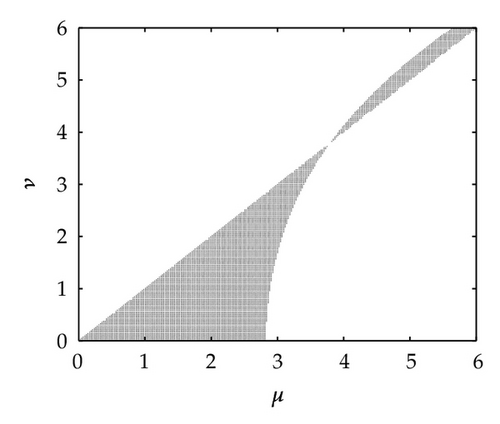
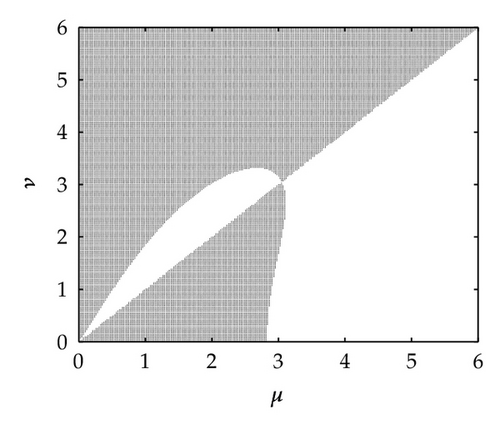
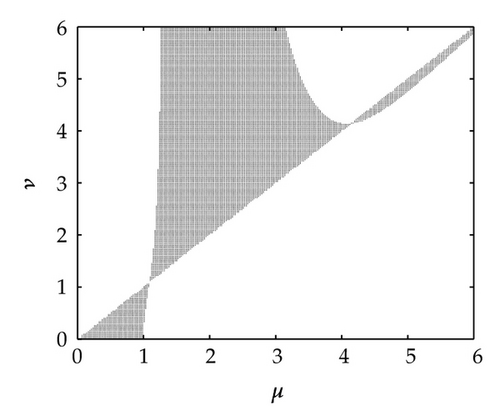
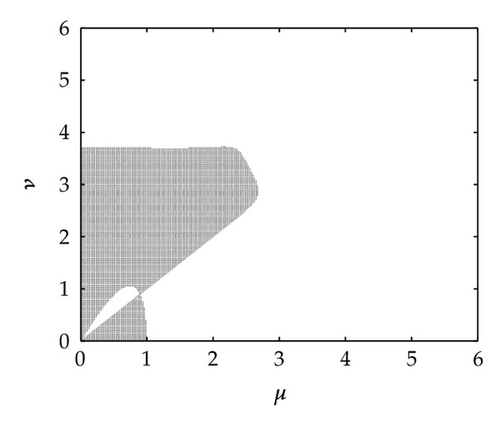
Definition 5.2. The quantities
By definition, an FRK method has zero phase lag and zero dissipation when applied to the standard linear oscillator (5.1) whose frequency λ coincides with the fitting frequency ω. That is to say, ϕ(μ, μ) = 0, d(μ, μ) = 0.
- (i)
Simos4:
() - (ii)
FRK4:
() - (iii)
FRK5a:
() - (iv)
FRK5b:
()
Note that if the update of (2.1) is phase-fitted and amplification-fitted, it must be true that ϕu(μ, μ) = 0 and du(μ, μ) = 0, as is verified above for the two methods FRK4 and FRK5b.
6. Numerical Experiments
- (i)
FRK5a: the seven-stage RK method of order five given by (4.17) and (4.20) in Section 4 of this paper;
- (ii)
FRK5b: the seven-stage RK method of order five given by (4.17) and (4.28) in Section 4 of this paper;
- (iii)
Simos4: the RK method of order four presented in [23], that is, the four-stage FRK method of order four given by (4.1) and (4.12) in Section 4 of this paper;
- (iv)
FRK4: the four-stage RK method of order four given by (4.1) and (4.12) in Section 4 of this paper;
- (v)
ARK4: the second four-stage adapted RK method of order four given in the Subsection 3.2 of Franco [11];
- (vi)
EFRK4: the four-stage exponentially fitted RK method of order four given in [26];
- (vii)
RK4: the classical RK method of order four presented in [3] (the prototype method of Simos4 and FRK4);
- (viii)
RK5: the classical RK method of order five presented in [3] (the prototype method of FRK5a and FRK5b).
Problem 1. Consider the following orbit problem studied in [27]:

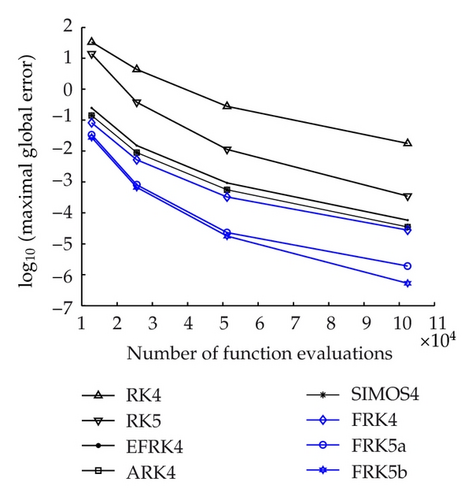
Problem 2. Consider the following linear problem studied in [9]:
Problem 3. Consider the prey-predator system in ecology (see [28]) as
In this experiment, we take the values of parameters α = 2, β = γ = δ = 1 and take initial data u0 = 1.6, v0 = 2.2. We select the fitting frequency ω = 1.0075 and integrate the equation on the interval [0,30] with step sizes h = 1/2i, i = 2,3, 4,5. The numerical results are presented in Figure 4(a).
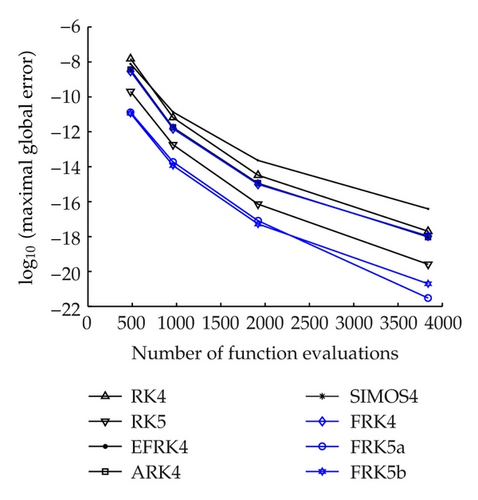
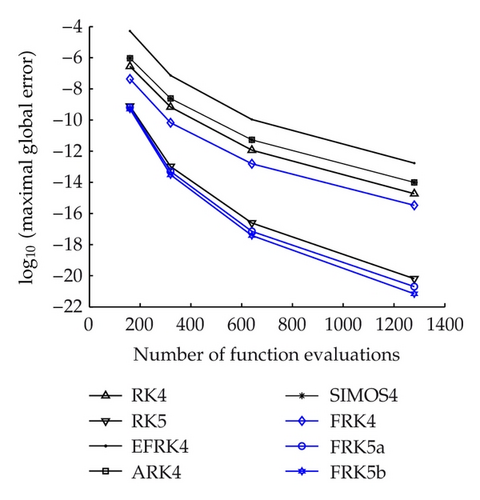
Problem 4. We consider the following two-gene regulatory system without self-regulation (see Widder et al. [29] and Polynikis et al. [30]):
The solution of the system is an equilibrium of the system (6.5). Now we take the values of parameters as follows:
In this experiment, we take initial data (0.6,0.8,0.4,0.6) and select the fitting frequency ω = 1.48. The problem is integrated on the interval [0,20] with step sizes h = 1/2i, i = 1,2, 3,4. The numerical results are presented in Figure 4(b).
It can be seen from Figures 3 and 4 that the FRK methods are more efficient than their prototype RK methods and are more efficient than the other frequency depending methods of the same algebraic order.
7. Conclusions
In this paper, classical Runge-Kutta methods are adapted to the time integration of initial value problems of first order differential equations whose solutions have oscillatory properties. The newly developed phase-fitted and amplification-fitted Runge-Kutta methods (FRK) adopt functions of the product ν = ωh of the fitting frequency ω and the step size h as weight coefficients in the update. FRK methods have zero dispersion error and zero dissipation error when applied to the standard linear oscillator y′ = iωy. That is to say, they preserve initial phase and amplification with time. Therefore, FRK integrators are a kind of integrators which preserve the oscillation structure of the problem.
As the fitting frequency tends to zero, FRK methods reduce to their classical prototypes methods. Furthermore, an FRK method has the same algebraic order and the same error constant with its prototypes method. Numerical experiments illustrate the high efficiency of FRK methods compared with their prototype methods and some other frequency depending methods like exponentially fitted RK type methods.
Theorem 3.3 gives a pair of sufficient conditions for modified RK type methods to be phase-fitted and amplification-fitted. The coefficients of the methods Simos4 and FRK5a are obtained with these conditions combined with an appropriate number of order conditions associated to low order trees. Since the updates of the methods FRK4 and FRK5b are also phase-fitted and amplification-fitted, they may be more efficient than those methods whose updates do not have this property.
In practical computations of oscillatory problems, the true frequency is, in general, not available. The fitting frequency contained in an FRK method is just an estimate of the true frequency. Sometimes the choice of the value of the fitting frequency ω for the FRK method affects their effectiveness to some extent. For instance, in the experiment of Problem 1, we find that the value of ω = 1.0007 is superior to the usual choice ω = 1. For approaches to estimating principal frequencies we refer to the papers [31–36].
This paper provides a convenient approach to constructing FRK methods. Other effective approaches are possible. For example, the fitting frequency can also be incorporated into internal coefficients aij or into nodes ci just as in [12]. Or frequency-dependent coefficients may be introduced to the terms yn in the modified (2.1) as in [26]. In these cases, the internal stages can also be made phase-fitted and amplification-fitted.
Acknowledgments
This work was supported by the National Natural Science Foundation of China (Grant no. 11171155), the Fundamental Research Fund for the Central Universities (Grants no. Y0201100265 and KYZ201125), and the Research Fund for the Doctoral Program of Higher Education (Grant no. 20100091110033). The authors would like to thank the referees for their valuable comments and suggestions.




